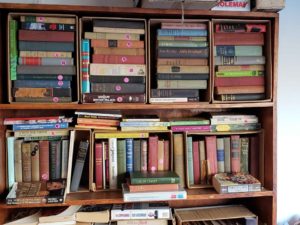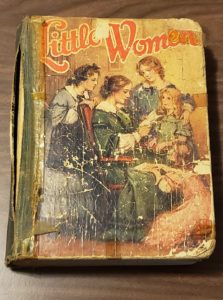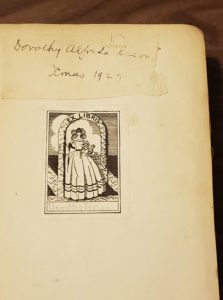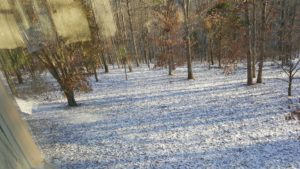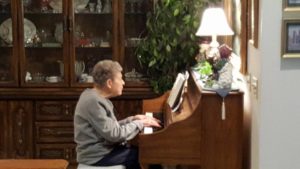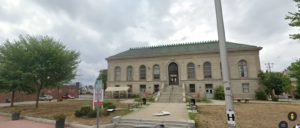
Right now, say for the last three years, I’ve spent a fair amount of time in libraries. I met our pastor for coffee from time to time in the Bentonville Public Library. The writing groups I’m in meet in libraries, either the Rogers Public Library or the Bella Vista Public Library. So four times a month on average I’m in a library. That’s not a lot, but it got me to thinking about libraries I’ve been in and memories I have with them.
Growing up in Cranston, Rhode Island, you would expect me to have memories of libraries there, but I have none. I don’t think we ever went to public libraries in Cranston. They were a little too far to walk, there were no convenient bus routes, Mom didn’t drive much, and Dad didn’t take us, so for whatever reason we weren’t library patrons in our hometown. In my adult years, when visiting the hometown, we took our kids to Cranston Public Library—in a building that wasn’t there when I grew up—when we were home visiting Dad.
I don’t think our elementary school had a library, and I have almost no memories of a library at my junior high school. I know there was one there, and I used it, but don’t remember it. But I remember our high school library. I wasn’t in it too often, but was some. One main memory I have was a date in the library. I was talking with my sister’s best friend, two years older than me, about how I had never had matzoh (she’s Jewish). So she said she would bring some to school and share it with me. This was my sophomore, her senior year. We agreed to meet in the library a half hour before school on a certain day. We sat at one of the tables off in a corner, ate matzoh and shared pleasant conversation.
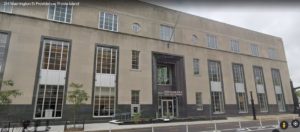
You say that’s not much of a date, and you’re right. But, hey, went you had as few dates as I did (4 total in 9th through 12th grades, only 3 if you don’t count the matzoh date), you count everything you can as a date.
But, strangely enough, I have many more memories of public libraries in Providence, Rhode Island. I remember it was in 8th grade, after Mom had died. I had a history research and report assignment. Whatever library was in junior high didn’t have books that helped me. So I got Dad’s permission to hop on the bus and ride to the Elmwood Ave. Branch of PPL. We lived four house lots off of Reservoir Ave., right on a bus stop. The bus also stopped right in front of the Elmwood branch. You had to cross Reservoir twice on foot, but I think we had some traffic signals not far away.
So I did that. It must have been around wintertime, because I remember it was dark. I crossed Reservoir, caught the bus, rode it toward downtown Providence, got off at Elmwood branch, crossed Reservoir again, and entered a world of books. I still have some idea of the layout, of going to the history books and finding ten books that were suitable for the report. I spent an hour or more reading and taking notes (I didn’t have check-out privileges at PPL). I listed all ten books. Then I went home by bus. This probably happened from around 7 to 9 p.m. If memory serves me correctly, I did this a second time for this report.
As a side note, I listed all ten books in the bibliography of my report, even though I really only used two of them in writing the report. I remember I got an A on the report, and the teacher wrote, “Great bibliography!”
I may be unclear about one part of this. When Mom died in August 1965, Dad’s shift at ProJo ran from 7 p.m. to 3 a.m, usually with an hour or two of overtime. At some point they moved him to a 4 p.m. to 12 a.m. shift, usually with two hours of overtime. If his change of shift happened after my 8th grade year, it’s possible that Dad drove me to the library as he went to work, and I took the bus home. No matter.
When I got to high school, the Elmwood branch seemed inadequate, I guess, because I took the bus to the main PPL in downtown Providence and did research there. I remember it was closed stack when I first started doing this and open stack by the time I graduated high school. You wasted a lot of time waiting for someone to find the books you needed and bring them to you. The open stack shifted the searching function to you. It still took time, but at least you could look at other, nearby books once you found the one you wanted.
I probably went to PPL Main Branch between five and ten times per school year. I kind of remember the layout. In fact, I remembered where both the Main branch and Elmwood branch were and found them easily on Google Earth. They are still in the same buildings and look the same as I remember them. I suspect, of course, that the insides are much changed, as technology updates have surely been made. No more card catalogue. Yes, that’s how I found those history books at Elmwood: looking in the card catalogue, finding one book that sounded good, finding that shelf, and see a great treasure before me spread out left and right, up and down.
I hope my grandchildren will have equally fond memories of libraries. I try to take them our ours whenever they visit, and to theirs whenever I visit them. We have a sizable library of books in our own home—as they do in theirs—but it’s not quite the same.
And, before some of you express being aghast at a 13 or 14 year old boy taking the bus in Providence, Rhode Island unaccompanied by an adult, after dark, all I can say is it was a different world and a different city then. And greatly different family circumstances that required it.
